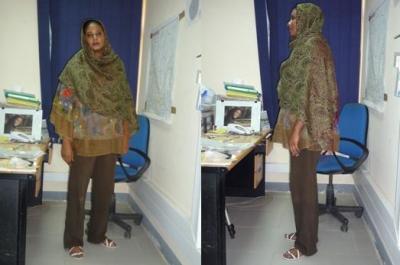TEXT: Sudan court ‘graphic’ ruling on female journalist
September 13, 2009 (KHARTOUM) — The written decision by a Sudanese judge charging a female journalist with indecent clothing demonstrates the dilemma of similar girls who fear that their cases would come to the public.

She refused to concede to the charges like most of the other girls and asked that her case be heard in court with the presence of her attorney.
After over a month of both international publicity and condemnation, the judge Mudathir Al-Rasheed Sid Ahmed found Hussein to be guilty under Article 152 of Sudan’s 1991 penal code and ordered her to pay a fine of 500 pounds ($200) or in the alternative be jailed for a month.
Eyewitnesses and the defense team said that the judge was in a rush to indict Hussein and did nit allow for cross examination of the prosecution witnesses.
They also expressed surprise that the judge did not use “common sense” as the outfit worn by Hussein at the hearing is the same one she had on when arrested asserting that it contradicts the witnesses testifying against her.
The judge spared Hussein the flogging penalty included in the law that was inflicted upon the other girls caught with her likely to avoid further international outcry.
Hussein refused to pay the fine and chose the jail sentence. However, a day after she was admitted to Omdurman prison for women, the head of the journalist union, widely viewed as a pro-government body, Mohyideen Titawi announced that they have paid the fine and received a judge order to release her.
Many journalists and observers told Sudan Tribune from Khartoum that they believe that Titawi was nudged by the government to pay the fine to avoid escalation of the international public relations nightmare created by the case.
Below is the text of the findings by the Judge Mudathir Al-Rasheed Sid Ahmed of whether Lubna Hussein was dressed indecently.
The hard evidence has clearly indicated that the defendant was wearing a revealing outfit and a flagrant breach of public morality as the complainant stated in his statement on page (2) of the record.
“Defendant was wearing tight pants and blouse with short and transparent sleeves with openings on the sides and composting pants and her head was exposed because she was not wearing scarves”.
Witness evidence as it came first page indictment (6) of the record says:
“Defendant was wearing pants and a blouse and the pants were tight and flashy and shows from underneath it the thighs and the outline and the form of the underwear and the color of her panties that can clearly be seen which is beige in color and short shirt with sleeves up to her elbow and it is transparent and light reflecting everything inside it within such as the shape and form of the bra and that the start of her chest is showing because the blouse opening and it also has two holes on the side lengthwise from top to bottom, and there is a gap between the confluence of the shirt so that they appear able to view the navel and the underwear of the accused”.
The witness recounted the details of that second indictment in his words on page (12) of the record:
“The accused of wearing a green blouse and it was short and transparent, showing her navel and also showing her bra and the sleeves were reaching only barely up to her elbow and her trousers were tight and her underwear was showing and her hair was exposed”.
Based on this evidence, we decide that the defendant was wearing a provocative outfit through which it shows all parts of the body of the woman’s charms, and shows the underwear and revealing her hair as she sat inside a nightclub full of dancing and singing with mingling between women and men, and this cafe is a public place as defined in the comment of Dr. Mohamed Awad Ali Mohyideen on this code that the public space is attended by people without discrimination and examples like public roads and public squares, shops and places of public entertainment.
(ST)
